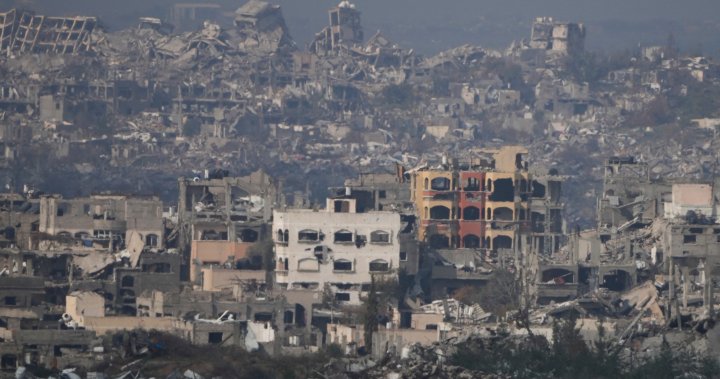Prime Minister Benjamin Netanyahu said Thursday that a “last-minute crisis” with Hamas was holding up Israeli approval of a long-awaited ceasefire that would pause the fighting in the Gaza Strip and release dozens of hostages. Israeli airstrikes, meanwhile, killed at least 72 people in the conflict-ravaged territory.
Netanyahu signaled there were issues with the deal shortly after U.S. President Joe Biden and key mediator Qatar announced it was complete. That created a dual reality: Conflict-weary Palestinians in Gaza, the relatives of hostages held there and world leaders all welcomed an agreement, expected to begin Sunday, even as Netanyahu said it was not yet finalized.
It was not yet clear if Netanyahu’s statements merely reflected jockeying to keep his fractious coalition together or whether the deal was at risk.
The Israeli Cabinet was expected to vote on the deal Thursday, but Netanyahu’s office said they won’t meet until Hamas backs down, accusing it of reneging on parts of the agreement in an attempt to gain further concessions, without elaborating.
Izzat al-Rishq, a senior Hamas official, said the militant group “is committed to the ceasefire agreement, which was announced by the mediators.”
The deal announced Wednesday would see a scores of hostages held in Gaza released and a pause in fighting with a view to eventually wind down a 15-month conflict that has destabilized the Middle East and sparked worldwide protests.

Hamas triggered the conflict with its Oct. 7, 2023, cross-border attack into Israel that killed some 1,200 people and took 250 others hostage.
Israel responded with a fierce offensive that has killed over 46,000 Palestinians, according to local health officials, who do not distinguish between civilians and militants but say women and children make up more than half of those killed. Israel says it has killed over 17,000 fighters, without providing evidence.
The military campaign has also leveled vast swaths of Gaza, and pushed around 90% of Gaza’s population of 2.3 million people from their homes. Hundreds of thousands are struggling with hunger and disease in squalid tent camps on the coast, according to United Nations officials.
Netanyahu faces heavy internal pressure
Netanyahu’s office earlier accused Hamas of backtracking on an understanding that he said would give Israel a veto over which prisoners convicted of murder would be released in exchange for hostages.

Get daily National news
Get the day’s top news, political, economic, and current affairs headlines, delivered to your inbox once a day.
The Israeli prime minister has faced great domestic pressure to bring home the scores of hostages, but his far-right coalition partners have threatened to bring down his government if he makes too many concessions. He has enough opposition support to approve an agreement even without those partners, but doing so would weaken his coalition.
One of his far-right allies, National Security Minister Itamar Ben Gvir, has already come out against the deal. Another, Bezalel Smotrich, posted on X late Wednesday that he was demanding “absolute certainty” that Israel can resume the war later, calling the current deal “bad and dangerous” for Israel.
The departure of both of their factions would seriously destabilize the government and could lead to early elections.

A night of heavy Israeli strikes
Palestinians in Gaza reported heavy Israeli bombardment overnight as people were celebrating the ceasefire deal. In previous conflicts, both sides have stepped up military operations in the final hours before ceasefires as a way to project strength.
“We were expecting that the occupation would intensify the bombing, like they did every time there were reports on progress in the truce (negotiations),” said Mohammed Mahdi, who fled his home a few months ago and is sheltering in Gaza City.
Ahmed Mattar, who lives near the city’s Al-Ahly hospital, said he heard “massive airstrikes” overnight.
Gaza’s Health Ministry said Israeli strikes have killed at least 72 people since the ceasefire deal was announced. It said the toll from Thursday’s strikes only includes bodies brought to two hospitals in Gaza City, and that the actual toll is likely higher.
“Yesterday was a bloody day, and today is bloodier,” said Zaher al-Wahedi, head of the ministry’s registration department.
An Associated Press reporter on the Israeli side of the border near Gaza heard more airstrikes and artillery fire on Thursday.
Destroyed buildings by Israeli bombardments as seen inside the Gaza Strip from southern Israel, Thursday, Jan. 16, 2025.
AP Photo/Ariel Schalit
A phased withdrawal and hostage release with potential pitfalls
Under the deal reached Wednesday, 33 of some 100 hostages who remain in Gaza are set to be released over the next six weeks in exchange for hundreds of Palestinians imprisoned by Israel. Israeli forces will pull back from many areas, hundreds of thousands of Palestinians would be able to return to what’s left of their homes, and there would be a surge of humanitarian assistance.
The remainder of the hostages, including male soldiers, are to be released in a second — and much more difficult — phase that will be negotiated during the first. Hamas has said it will not release the remaining captives without a lasting ceasefire and a full Israeli withdrawal, while Israel has vowed to keep fighting until it dismantles the group and to maintain open-ended security control over the territory.
Ceasefire leaves questions about Gaza’s future unanswered
Mediators from Egypt, Qatar and the U.S. are expected to meet in Cairo on Thursday for talks on implementing the agreement, which came after a year of intensive talks with repeated setbacks.
U.S. President-elect Donald Trump’s Mideast envoy joined the talks in the final weeks, and both the outgoing administration and Trump’s team are taking credit for the breakthrough.
Many longer-term questions about post-conflict Gaza remain, including who will rule the territory or oversee the daunting task of reconstruction.
Israel has come under heavy international criticism, including from its closest ally, the United States, over the civilian toll in Gaza. It also blames Hamas for the civilian casualties, accusing it of using schools, hospitals and residential areas for military purposes.

Hamas, a militant group that does not accept Israel’s existence, has come under overwhelming pressure from Israeli military operations, including the invasion of Gaza’s largest cities and towns and the takeover of the border between Gaza and Egypt. Its top leaders, including Yahya Sinwar, who was believed to have helped mastermind the Oct. 7, 2023, attack, have been killed.
But its fighters have regrouped in some of the hardest-hit areas after the withdrawal of Israeli forces, raising the prospect of a prolonged insurgency if the conflict continues.
Shurafa reported from Deir al-Balah, Gaza Strip and Magdy from Cairo. Associated Press reporter Sam McNeil in southern Israel contributed.





